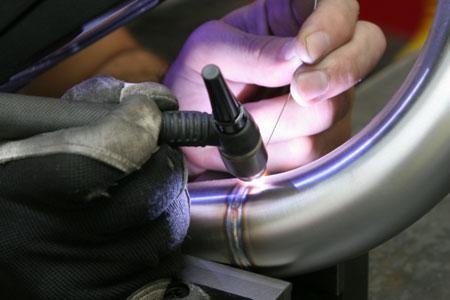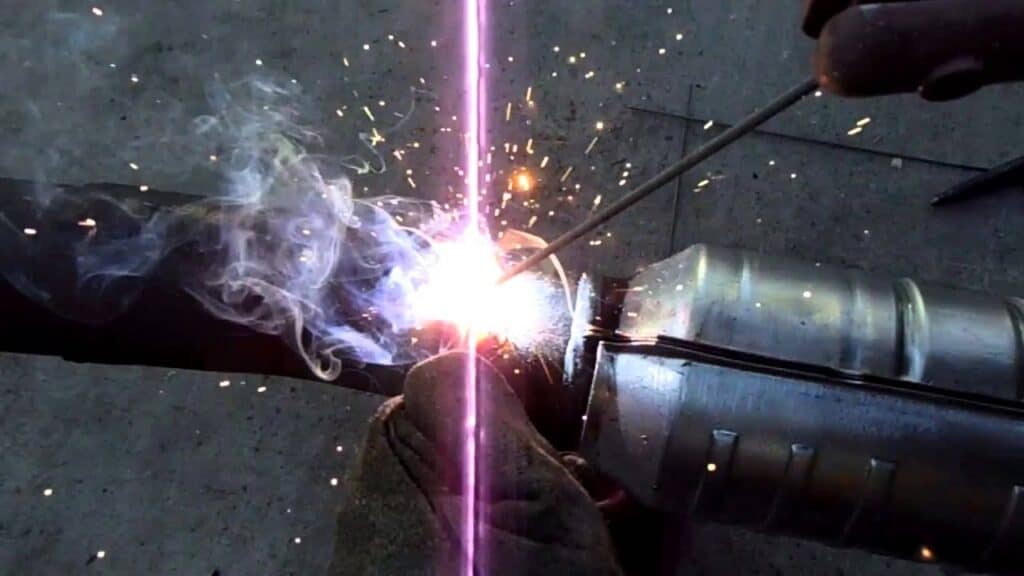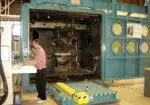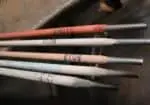If you are reading this article, it’s probably because you are planning on welding an exhaust pipe. But you probably don’t know which type of welder will get the job done and provide the best results.
 To weld well, one needs the proper tools and accessories as well as the proper method depending on what type of metal you wish to weld.
To weld well, one needs the proper tools and accessories as well as the proper method depending on what type of metal you wish to weld.
To weld an exhaust pipe, we recommend using a MIG welder because it works incredibly well in the welding of thinner metals. The exhaust pipes of vehicles are generally made with thinner metals so that they are lightweight when attached.
Exhaust pipes are generally constructed in steel however they can be found in steel tubing that is aluminized or stainless steel for corrosion resistance properties.
Wouldn’t it be easier to just clamp an exhaust pipe?
By welding your exhaust pipe, the attachment will be stronger, tighter, and longer-lasting. If you clamp and it becomes, by chance, unfastened, you’ll risk broken exhaust pipes or pipes that drag along the ground.
Welding the Exhaust Pipe
Repairing or welding an exhaust pipe can be incredibly uncomfortable because trying to do it underneath a car is impossible, and you should remove the entire system if you want to do a really great job. Remember to note how the exhaust system was placed so that you weld it into the correct position.
If you are going to weld, clean up your exhaust system using a wire brush. If you notice damaged metal or spots that are worn down, remove the bad metal and replace it with some sheet metal strips, or a section of new pipe. Place your tubes in a straight position or at the correct angle for bonding them together if necessary.
Things to know when selecting a welder for exhaust pipe welding
If you intend on welding an exhaust pipe there are some important qualities that you should look for when picking up that welder. Here are some basics to consider:
Power. Power is important and you need to consider both power input and power output!
1.) Power Output for the job
The first thing you should determine is the power output you want. Much of this will depend on what you weld, in this case, an exhaust pipe, and how often you want to do this.
Is this a one-time welding job for personal use? For occasional welding, 100 amps should be fine, however, if you weld more often or perhaps will decide to weld things other than an exhaust pipe, a more industrial output such as 140 amps would be a better choice.
2.) Power Input
Ideally, you might look for something that keeps down your electricity costs. If you choose a 140 amp welder, 120 volts of power should suffice. A welding machine that uses 220 to 240 of electrical current will weld probably anything you can think of.
3.) The Duty Cycle. The term duty-cycle indicates how long a welder can operate within a ten-minute time slot without overheating. You will find that this concept is usually measured in percentages. A good example of what this means is “40% at 100a”.
This signifies that the welder can run non-stop for a total of 4 minutes. Then it must rest for six minutes. Lower output of the power will permit welders to operate for a longer time without the required rest.
4.) Transport. The larger a welder with greater output, the heavier it will be. You should consider storage space, if you need to move it frequently and how often you will use it.
5.) Wire Feed. You may want to look for a welder with an automatic feed setting. If the speed of the wire feed is too slow, the wire upon touching the metal will disappear leaving a messy weld.
A speed that is too fast will, you’ll end up with too much wire and spatter. An automatic setting will adjust to the power output.
6.) Safety. Safety should always be a consideration when welding. Some welding machines will feature thermal overload shut down or a contactor that will cool down the wire until the trigger is used.
Advantages of Using MIG Welder for welding exhaust pipe
Some of the principal advantages are:
-
-
- It’s fast. Thanks to the electrode wire that is fed without interruption into the welder, there are fewer stops and starts during the process. It also permits a longer welding pass, meaning fewer passes to weld a larger joint.
- It’s a good solution for many types of metals and their thickness.
- It can be used in many positions to facilitate difficult welding.
- There’s not a lot of necessary clean-up and no splatter when welding.
- No waste. By using welding wire, you can use it all instead of wasting a part as in other types of welding.
- It’s easy!
-
A few disadvantages include:
-
-
- It’s a bit more expensive for the equipment than stick welding.
- It’s only useful with thin and medium-thick metals to approximately 14mm.
- It does require an external gas source.
- If used outdoors, wind can disturb the shielding gas used in the welding process.
-
What is MIG Welding and Why Use it?
MIG stands for Metal Inert Gas Welding. This is just one of the various welding techniques that use electrical power to melt pieces of metal and join them together. It is a relatively quick way to weld and pretty easy.
Thanks to the use of electricity, an electrical arc is established between an electrical node and the material to weld. This arc will melt an electrode wire which creates the weld as it is deposited. When the heat source is taken away, the heated metal or weld pool will cool down. Upon cooling it solidifies creating fused metal or the “weld”.
Today’s MIG welders are usually fed electrode wire into a hand-held welder while a supply of shielding gas flows into the MIG welder as well. Shielding gas is generally carbon dioxide, argon, or perhaps some combination. The use of the gas is to protect the pool of fused metal from gases in the atmosphere that could, potentially, weaken your weld.
While welding thinner metals well may take a little practice, once you have determined the heat setting and the speed of moving your electrode, it’s not hard at all to weld an exhaust pipe.
MIG welding is an effective option for welding various types of metals such as aluminum, carbon steel, copper, magnesium, nickel, silicon bronze, stainless steel among other allays.
When using MIG welding, remember to clean the metals and to use cuts that are straight, so the pipe is perfectly aligned. Welding beads should remain small at less than one-half inch, so you don’t burn through.
See also: Can you MIG weld without Gas
Problem Solving with MIG Welding
Four basic mishaps can occur when using an MIG welder:
1.) Incomplete fusion. Here it is important not to permit the electrode to position itself in front of a weld pool.
2.) Penetration that is incomplete. This is relatively simple to correct. Increase the amount of wire fed into the welder while at the same time reducing the wire that will protrude out of the welder.
3.) Penetration that is excessive. Here you will need to reduce the size of the gap that you are attempting to fill.
4.) Whiskers. To avoid whiskers, the wire should remain at the front or beginning of the weld. Keep the weld smaller and don’t allow the electrode wire to protrude as much.
Alternative Welding Methods for Welding Exhaust Pipe
Stick Welding for Exhaust Pipe
Stick welding is similar in principle to MIG welding. It does manage better with rusty metal or dirty metal, but it is always advisable to clean any metal before welding in any case.

This type of welding can use small rods and low amps. However, controlling your welding pool will be more difficult because even the slightest movement can disturb the bead. Creating the arc on smaller round tubing can also be a bit tricky.
Stick welding can be done outdoors or indoors and in any type of weather. There are no problems with dirt, paint, or rust and the equipment is affordable. You will probably use a number of electrodes and the one real hazard is the formation of slag that can eventually cause leaks.
Flux Core Welding for Exhaust Pipe
The greatest difference when using a flux core welder as opposed to a MIG welder is that the wire must protrude more to about one-half inch. The amperage should also be kept low. Manifolds in cast iron can be welded but it is not recommended in any case.
This type of welding can be accomplished without a gas shielding tank. It will probably cost a bit less than welding with MIG and give better penetration. The downside is that it can burn through thinner metals meaning you need to be very precise when working. It also tends to cause more splatter.
TIG Welding for Exhaust Pipe
This type of welding is ideal for thin sheets of metal. The difficulty with using this method for exhaust pipe welding is that surfaces must be super clean with no dirt, oil, paint, or rust. This can be accomplished by cleaning it with acetone.
It requires precise output because exhaust pipes are soft. This type of welding will produce less heat than other methods. While it is a very effective method, it requires a great deal of time to get set up and sufficiently clean the exhaust system.
See also: What kind of Gas to use for TIG welding?
Safety Tips
-
-
- Wear welding gloves that are fireproof.
- Wear safety shoes or boots or at least closed-toe footwear in case of sparks
- Wear a welding mask. This will prevent fumes from reaching your face as well as any UV rays.
-
FAQ
Is it possible to weld the exhaust pipe?
The exhaust pipe can be welded. Much depends on the amp output of the welder. If you possess a heavy-duty welder, it may not be appropriate for welding thin metals.
Must an exhaust pipe be welded, or can I fix it another way?
A temporary fix might be a clamp that can cover cracks or holes.
My exhaust is stainless. Can I use an MIG welder?
Absolutely, even though it is not easy. If you want to do so, you need a gun liner where MIG wire has never been used to avoid contaminating. You will also need the correct type of shielding gas.
What kind of welder should I use for exhaust?
MIG, TIG, and Stick welding can be used. TIG is used for systems that need to maintain a clean appearance. MIG works well with steel and stainless. Stick welding is more difficult with the thinner metals used in exhaust pipes, but if you have the necessary skill, it can be done successfully.
A Final Thought
When deciding to weld an exhaust pipe, you will need to research a bit. The choice of an MIG welder should get the job done and a flux core welder can also accomplish your welding necessities. These are probably the best two choices especially if you are a beginner at welding.






